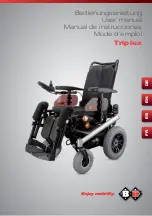
9
The wheelchair has been designed to be used
either by a seated user or carer/attendant,
primarily for use in indoor environments, refer
to
“
Limitations of Use
”.
The wheelchair has, in its standard format,
been designed to accommodate users who
have all limbs intact and have sufficient upper
body strength to maintain a safe position within
the wheelchair without the addition of
supporting aids.
Adaptations from the standard wheelchair
format are available to accommodate users
who do not meet these criteria, these will only
be considered after a suitable risk assessment
has been carried out by the product prescriber.
When prescribing wheelchairs for use by full or
partial amputees (above or below knee, single
or double) it is important to recognise that
lower limb amputation will affect the sitting
centre of balance of the wheelchair.
The impossibility of generalising the individual
ability of a wheelchair user means it is
imperative that the product prescriber carries
out a full stability evaluation to ensure that the
user is safe in the use of the wheelchair and the
risk of the wheelchair tipping is minimised.
The wheelchair should only be used in
accordance with the safety advice given within
this user guide. Failure to follow the
recommended advice within this user guide
could lead to personal injury.
Your powered wheelchair is a Class A –
compact, manoeuvrable wheelchair not
necessarily capable of negotiating outdoor
obstacles (EN12184) with a speed of 4 Kph for
use primarily in an indoor environment, refer to
“
Limitations of Use
”.
Under no circumstance must the top speed of
the powered wheelchair be increased beyond
what has been set at time of issue.
P R E A R I N G F O R U S E










































